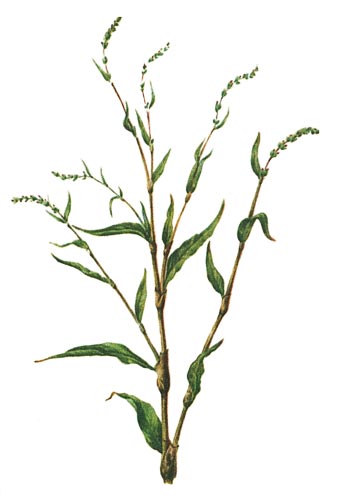Weeds
Persicaria hydropiper (L.) Spach - Smartweed
Systematic position.
Family Polygonaceae Juss., genus Polygonum L.Synonyms.
Polygonum hydropiper L.Biological group.
Annual weed.Morphology and biology.
Plant is 20-70 cm in height, with straight or ascending, usually branched, glabrous, reddish stem. Leaves are oblong-lanceolate or lanceolate, sharp, narrow-cuneate at base, often with translucent gland-dots and dark spots, situated below the middle, with short petioles, having bitter pepper taste. Ocreae are reddish, glabrous from outside, with marginal cilia. Flowers are collected in slender, spike-shaped, loose racemes, interrupted in their lower part, with nodding top; flower stalks are glabrous. Perianth is pink or white, densely covered from outside with indented yellow glandula-dots. Fruit is dihedral, convexo-plane or nearly trihedral dark-fulvous nutlet. The plant flowers in May-August and bears fruits in July-September. Every plant produces 300-500 seeds on average.Distribution.
Europe, Asia, and North America. Within the Former Soviet Union, it is distributed in the European part, in the south of Siberia and the Far East.Ecology.
P. hydropiper grows along banks of freshwater reservoirs, in ditches, grassy bogs, along roadsides. This plant prefers wet and rich soils. It cannot withstand shade.Economic significance.
P. hydropiper infests grain, tilled and flax crops, growing on wet soils, mainly in zones of middle and southern taiga and broadleaf-coniferous forests; in the south, it may occur in irrigated crops. It often grows on unimproved lands. Admixture of the smartweed seeds to the grain decreases the quality of flour. Herbal and medicinal plant. Control measures: autumn plowing, careful fallow treatment, purification of crop seeds.Reference citations:
Anon. 1996-2003. Polygonum hydropiper. Plants for a Future Database. http://www.pfaf.org/database/plants.php?Polygonum+hydropiperChikov, P.S., ed. 1983. Atlas of areas and resources of herbs of the USSR. Moscow: GUGK. 340 p. (in Russian).
Gubanov, I.A., Kiseleva, K.V., Novikov, V.S., Tikhomirov, V.N. 2003. Illustrated keys to plants of Middle Russia. V. 2. Moscow: KMK. 665 p. (in Russian).
Keller, B.A., ed. 1934. Weed plants of the USSR. V. 3. Leningrad: AN SSSR. 448 p. (in Russian).
Komarov, V.L., ed. 1936. Flora of the USSR. V. 5. Moscow-Leningrad: AN SSSR. 762 p. (in Russian).
Nikitin, V.V. 1983. Weed plants of the USSR flora. Leningrad: Nauka. 454 p. (in Russian).
Shlyakova, E.V. 1982. Keys to field weed plants of Non-Chernozem zone. Leningrad: Kolos. 208 p. (in Russian).
Tsitsin, N.V., ed. 1962. Atlas of medicinal plants of the USSR. Moscow: State Publishing House of Medicinal Literature. 704 p. (in Russian).


